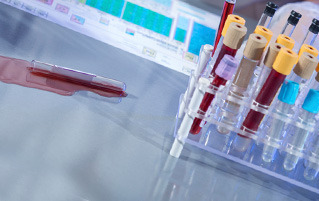4 Insane Realities As A Real CSI Agent (You Don't See On TV)

The basic formula of a procedural crime show is always the same: Bad guy murders somebody, police stand around sipping coffee and making puns, forensics wizards come in and wave their magic science wands, bad guy is brought to justice, roll end credits. But is that the way it works in reality? To find out, we spoke to forensic scientist Jennifer Forbes. Here's what she told us:
Real Crime Scenes Don't Look Like They Do On TV

A real-life crime scene has more in common with Hoarders than with your typical crime drama -- it's covered in all manner of crap that could only be considered "evidence" of shoddy housekeeping. Oh, there are fingerprints, but they usually look like this:

Those are actually really clear, if you know what you're looking for.
In fact, by the time forensics gets to a murder scene, it's pretty remarkable if there's even a body there to examine. The cops don't want to deal with corpses. Well, nobody really wants to deal with corpses (if you get too excited about dead bodies they tend to look at you funny). But the police especially don't want the body around, so they usually call an ambulance to take the victim away before he inevitably shits his pants.
Then there's the actual collection of evidence. We don't just shine a black light around all willy-nilly and swab a computer keyboard or two. No, we collect everything in the room, if not everything in the house. And when said house looks like this, it can get downright tedious (not to mention smelly):

Consider yourself lucky for never having to ask, "Are mummified cats considered evidence?"
Oh, and speaking of black lights, I'm about to ruin every single detective show on TV for you right now. Ready? Here we go: Black lights don't detect blood. Well, they do, but not in the way TV depicts it. In college we had a session where my instructor took several fabrics and smeared various bodily fluids on them (forensics courses are ... interesting). Then she took us into a dark room and had us shine black lights on them, and that's when we discovered that blood absorbs UV light and appears as black splotches. So what's that bright, glowing fluid all the TV black lights are revealing? The answer, of course, is semen. Every single episode of CSI: Miami features David Caruso standing in a room absolutely drenched in man-batter.
Everything Is Infuriatingly Slow (And Computers Are Not Magical, Crime-Solving Boxes)

On TV, fingerprints from the crime scene arrive at the lab, a tech presses a button, and software isolates points on the fingerprints and flashes a match. Then they zoom and enhance to kill a few minutes of screen time. In the real world, while you can certainly run a fingerprint through the Automated Fingerprint Identification System and have it return a result, that takes about four days (AFIS swears it's an hour and a half, but they must run their lab out of a TARDIS or something). But, even then, you still have to input the fingerprint manually, which takes hours (more on that in a moment). I spent quite a bit of time with the Glendale, Arizona, Police Department's fingerprint expert, and she told me that she prefers to personally match fingerprints by sight rather than taking huge chunks out of her day to plug them into AFIS.

Of course, she also preferred to hand draw each pixel instead of opening a JPEG,
so she may be an anomaly.
Likewise, the average DNA test takes 24 to 72 hours -- and that's with a perfect sample and nothing else in the lab's queue. In college, I worked as an intern at a DNA lab, and the day they authorized my internship, they took a cheek swab so they could have my DNA on file in case of contamination (that, or clone me without my knowledge). Even with a professionally collected sample in a for-profit lab, I couldn't start work there for three days because that's how long it took to properly sequence my genetic leavings. And that can easily double when we collect a sample from anything that isn't a person, because then you've got to filter out all the cat hair and hobo pee to even get to a usable sample.

"How can you tell it's pee from a hobo?"
"... You really don't want to know."
With that in mind, consider that even though Phoenix is a pretty safe place, it still has around 120 murders a year. And for each of those murders, there are wounds to be swabbed, DNA and fingerprints to be taken, and mounds of other evidence to be cataloged. That sounds totally doable, until you add in the other 6,000 or so violent crimes (rape, assault, arson, etc.). Even if you assume that each of those has a hilariously lowballed 10 pieces of evidence, that's still 170 pieces of evidence appearing in Phoenix's labs daily. There's no way all that's getting processed or, hell, even started in one day -- and tomorrow it starts all over again. It's so bad that thousands upon thousands of rape kits across the country have been tossed onto shelves, never to be processed. It's like the warehouse scene at the end of Raiders Of The Lost Ark, but way more depressing and full of semen.

They've got middlemen working on it right now. Middle. Men.
That's quickly becoming a theme for this article.
There Is No Single Forensics Superperson

A TV crime lab is manned by one or two walking brains in lab coats who know how to do everything from fingerprinting to ballistics to stopping hackers by gang-banging the nearest keyboard. In reality, someone like me will be lucky to learn the basics of how a major mass spec machine works. And the emphasis there is on "basics." When you're learning on the job, it can take you up to six months to fully understand the workings of just one of those mystical gadgets, so you'll likely never learn to use them all. You'll learn one or two, depending on what your specialty is -- a list of careers in forensics looks like a massive brain dump from the world's most simultaneously boring and disturbing Scrabble player.

"Spectrophotometer."
"HOW DID YOU EVEN FIT THAT ON THE BOARD?!"
In Phoenix there are separate labs for fingerprints, DNA (as well as several independent labs for it), toxicology, ballistics, trace chemical (mass spectrometry), and trace physical (microscopes and such). Of those, the only ones that have any real crossover are the two trace labs, and they don't have the same people working in them. The morgue is even in a separate building that's only connected to the lab by a series of underground tunnels, presumably so it can be easily dynamited off when the zombie uprising hits.
Lab Techs Couldn't Care Less "Whodunnit" (Or They Shouldn't, At Least)

There comes a moment in every procedural crime show when the detectives know who did it, and all that's left is for our intrepid forensics team to step in and prove it before Ice-T loses his patience and starts slapping lab nerds. In actuality, lab techs aren't anywhere near the investigation. Chances are we don't even know what the suspect's name is. It's not that we don't care; it's that we literally can't care. That's because, psychologically, if you have a strong opinion on what you're looking for, you're damn well going to find it. It's been shown time and time and time again that when someone in the lab actually cares about who the perp is, they end up falsifying evidence because they want to put the Bad Guy behind bars. In some departments, the police aren't even allowed to talk to lab techs about cases for fear of misconduct.

"*cough*husbanddidit*cough*. Sorry, lingering cold."
As much as the cops might hate it at the time, it's far better for us to come up with independent results that might disagree with the investigating officer's theory. Don't believe me? Go ask one of the thousands of people the FBI recently found were wrongly convicted thanks to fucked-up forensic testimony.
Forensics is just never as cut-and-dried as Hollywood makes it out to be. To get an idea of what it's really like, imagine finding a puzzle piece on the sidewalk. Now, imagine someone demanding that, because you're holding that one, tiny piece, you need to tell them exactly what the entire puzzle looks like. Unless you have a catalog of every single puzzle ever made, you can't. Even if a tech is lucky enough to find that perfect fingerprint or DNA sample, it still means precisely squat unless we have that person's information in the system. If we do, then we might find him ... in a few months. But if he's never had his fingerprints taken, then we're totally screwed -- and, sadly, not in a "by the cute goth girl from NCIS" kind of way.

More like the metaphorical Dexter kind of way.
Jennifer has a blog where she teaches people to sew (she's a little bit all over the place). Jason is an editor for Cracked. He sincerely hopes his Facebook page doesn't glow under a black light.
For more insider perspectives, check out 5 Things I Learned as a Cop (That Movies Won't Show You) and 6 Realities of Buying Drugs (While Wearing A Wire).
Are you on reddit? Check it: We are too! Click on over to our best of Cracked subreddit.
Have a story to share with Cracked? Message us here.
